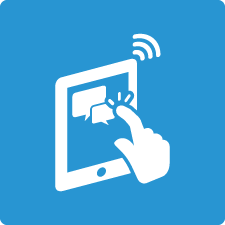I’m seeing a hybrid of mobile approaches that I find interesting. It raises interesting issues about where mobile technology is today and where it’s going.
The trend, especially on the shelves in the consumer space, is to create a bridge to augmented reality experiences and use QR Codes to get people there. The goal is to introduce consumers to augmented reality (AR) using a mobile technology they already understand: QR Codes.
I picked up the most recent example of this at a movie bin at a large retail store. The movie was “Echo,” and on the back of the DVD case was an invitation to scan a QR Code to learn more.
Editorial note (July 27, 2016): It’s important to note that, while this is the experience consumers are interacting with today, in the world of mobile, this is old technology. Today’s developers are light years ahead, even if consumers have yet to experience it. This is part of the challenge in educating your clients about AR since the pace of development is so rapid.

On the surface, it appeared to be a perfect use of QR Codes. As a shopper, I’m not sure if the kids will like the movie or not, so I scan the code, watch a clip, and make a decision. Perfect!
Except I wasn’t taken to a movie clip. I was taken to the App Store, where I was asked to download the Echo app. It was a strange way to experience the movie, I thought, and an extra step if the studio’s goal was to facilitate an in-store buying decision. But I played along.
After the app took its sweet time downloading, I was asked if I had a Blu-Ray or DVD (I assumed they meant player). I wasn’t sure why they needed this information, but I figured it was data gathering among the target audience. Then I was presented with a series of questions, including whether I wanted to save the DVD cover image or print it. Huh? At this point, I put the movie back and bought something else.
About a week later, I saw the app on my phone and, on a whim, tried again. The questions continued not to make sense to me, but after the third or fourth time I launched the app, I noticed the third to last bullet on the opening screen inviting me to hold the phone over the image. What image? The image they were asking me if I wanted to print?
Suddenly, I understood what was happening. They were offering an AR experience, and they wanted to know if I had the package on hand to launch it. In case I didn’t have the package (which meant I’d left the store without buying the movie), they were offering me an image to download and print, and use instead.
None of this was explained.

It took me awhile to get the AR experience to load. I’d forgotten that, unlike QR Codes, I had to hold the phone flat on the image rather than at any sort of angle so the software could match the cover image to the image map. I kept at it only because I remembered that, and unlike QR Codes (which are very forgiving), I was experiencing in real time just how much more finicky AR can be. Plus, the image download hadn’t worked in the app, so knowing what the studio wanted, I’d taken and printed a screen shot instead, so perhaps that was why the image recognition was a little slow.
Still, nothing was happening. Music from the movie was playing in the background, so I decided to be patient. No one, except maybe someone walking through the process simply for the sake of the walking through the process, would have stuck with it.
After 30 seconds or so (an eternity in the mobile world), I finally saw a big-eyed alien pop up. It began swooping around the screen, blinking and whirring. It ducked, dove, and made big, sweeping circles. A black hole popped up, and the alien dove in and out. That was it. No movie clip. It showed me how cute Echo is, but it told me nothing about the plot.
From a marketing perspective, the experience was a complete train wreck. First, it probably lost 90% of the people at the App Store. It probably lost the other 9.9% once the app was launched and there was no explanation for what to do next. The other .1% would have finally given up all hope once it took a long time for the experience to load. Then the experience had no value in promoting the buying decision anyway.

In the studio’s semi-defense, I think I get what they were trying to do. They were trying to provide a mobile experience without having to confuse people with a long, detailed explanation about how to use AR. They used a known quantity—QR Codes—to try to short-cut the process. Unfortunately, this is not a process that can be short-cut. The studio’s approach would work only for people who already understand AR and only if they had indicated upfront that this was really an AR application.
At the very least, the studio should have indicated that that the QR Code would lead people to an app that would launch an AR experience. This would have set expectations upfront, and if the user didn’t know how to navigate AR, they might have tried to figure it out if they thought it was worth doing so. The studio also needed to clearly explain how to how to launch the experience. Especially since they were relying on the better understood and more forgiving QR Code as a gateway.
All of this was too much for the Wal-Mart bin, and it is certain that the studio’s investment in the AR app didn’t provide much return. It’s not because of the QR Code interface.
The point? This was a long way to go to avoid having to introduce shoppers to AR, which says something about the challenges in AR adoption. With the more rudimentary approaches, they have to know there is an AR experience coming; how to scan the right area of the image (for example, not including any of the background); and to expect a delay between the scan and the launch of the experience (especially if they print the cover image on a printer at home), so they don’t give up and bail too early.
The point? This was a long way to go to avoid having to introduce shoppers to AR, which says something about the challenges in AR adoption. With the more rudimentary approaches, they have to know there is an AR experience coming; how to scan the right area of the image (for example, not including any of the background); and to expect a delay between the scan and the launch of the experience (especially if they print the cover image on a printer at home), so they don’t give up and bail too early.
This isn’t the first time I’ve seen QR Codes leading to AR experiences. How about you? Have you seen it? What do you think?



